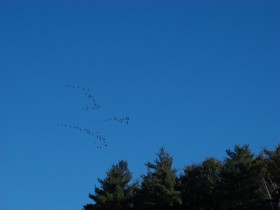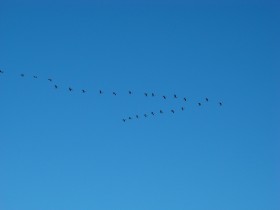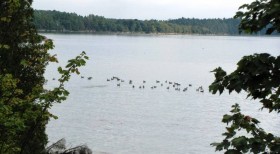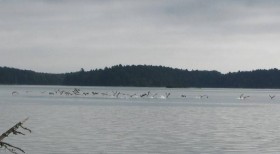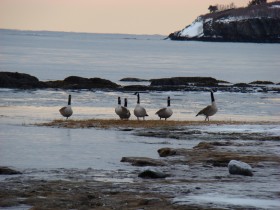by Patt Corr (retired – contact Brad Allen))
Wildlife Biologist,
Maine Department of Inland Fisheries and Wildlife
Description
The snow goose, white-fronted goose, Canada goose, and Atlantic brant occur in Maine. The white-fronted goose, snow goose and Atlantic brant are only observed in Maine as they migrate through. Among these birds, the Canada goose is the only goose that breeds, winters, and migrates through Maine. [About 100 are in the field above, with more along the tree-line! ] Arctic-breeding geese arrive in early October and most leave by November. Unlike ducks, a goose’s plumage does not differ between males and females and subadult and adult geese. Canada geese have a black bill, black legs, black feet, and black neck. Their head is also black with a white cheek patch, and their wings and back are brown.
Natural History
Food Habits. The Canada goose, more than any other species of waterfowl, has benefited from the production of crops. Geese browse on grasses and the leaves of clovers and consume cultivated grains. Clover, barley, wheat, rye, alfalfa, timothy, fescues, corn, oats, buckwheat, grain sorghums, and soybeans are among the most preferred. Large and open grain fields with an undisturbed body of water nearby to provide security, are essential.
Reproduction. Most Canada geese return to the same breeding area year after year and nest the earliest of any waterfowl. Maine Canada geese are from both local and arctic breeding areas. Birds begin nesting as early as March to as late as May, depending on the latitude of breeding areas. Canada geese form life-long pair bonds with their mate, but if their mate dies, the survivor will seek a new mate. Some Canada geese breed as early as two years of age, but most breed for the first time at three years of age.
The average clutch size is five eggs, but can range from 1-12 eggs per nest. The female incubates the eggs and may leaves the nest periodically to feed. The male watchfully guards the hen while she is on and away from the nest. The hen incubates her eggs for 25-30 days. About 70% of nesting pairs successfully hatch their eggs. Resident Canada geese are ready to fly at about 85 days. The family unit stays together until spring migration.
[Harpswell at N43° 48′ 55.0″ W69° 56′ 57.4″ September 22, 2012, 3:50 and 3:58 pm.]
Nest failures are caused by desertion, destruction of nest by predators, and destruction of nests by natural agents (e.g. flooding). Desertion and destruction of nest by predators account for about 90% of all failed nests. Some geese will re-nest after losing the first nest.
Survival. There is a wide range in mortality rates for geese due to the degree of shooting pressure. Immature birds have a higher mortality rate (39-65%) than adults (23-46%), and males have a higher annual mortality rate than females.
Historical Management in Maine
Distribution and Population. Prior to 1960, a breeding populations of geese was not present in Maine. The Department began a trap and transfer program of Canada geese from New Hampshire, New York, and Connecticut to establish a breeding population of geese in Maine. Also, the United States Fish and Wildlife Service trapped and transferred geese and raised them in pens on the Moosehorn National Wildlife Refuge. The young of these captive geese where released on the refuge to establish a local population. Due to these efforts, a resident goose population has been established and is increasing in Maine.
Season Changes. In 1995, the regular goose season was closed due to low production on the breeding areas coupled with overharvest. In 1996, a special early season was established to allow some harvest of resident Canada goose populations. This early season allows hunting between September 1 and September 25 in northeastern states.
Source: Closely followed with some editorial and content changes from “Geese” at http://www.maine.gov/ifw/wildlife/species/waterfowl/#geese (accessed September 17, 2011)
Additional information from Andrew Weik, “WATERFOWL ASSESSMENT,” January 19, 2005. Maine Department of Inland Fisheries and Wildlife. http://www.maine.gov/IFW/wildlife/species/plans/birds/waterfowl/speciesassessment.pdf (accessed September 19, 2011)



